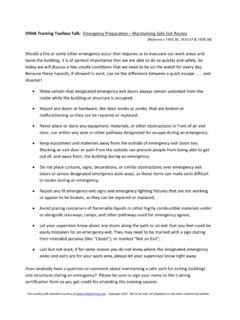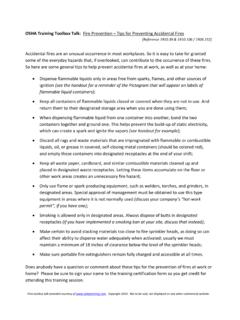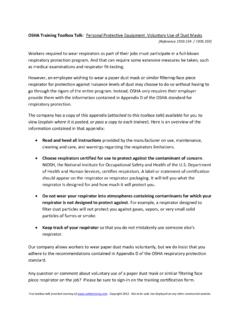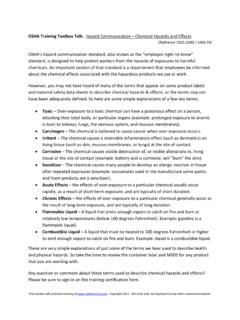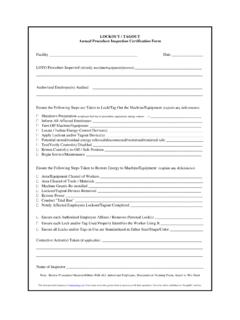Transcription of OSHA Training Toolbox Talk: OSHA’s Revised Haz-Com ...
1 Free Toolbox talk provided courtesy of Copyright 2013. Not to be sold, nor displayed on any other commercial website. OSHA Training Toolbox Talk: OSHA s Revised Haz-Com Standard Safety Data Sheets (SDS s) [Reference (f) / (f)] Most of you are probably familiar with Material Safety Data Sheets, called MSDS s, as these documents have been around for almost 30 years. However, MSDS s for products from various manufacturers and importers often look very different, which sometimes makes it very difficult to find specific safety and health related information about the hazards of a product. So OSHA recently Revised their hazard communication standard to require manufacturers and importers of hazardous products to replace their old MSDS s with new GHS-compliant Safety Data Sheets, also known as an SDS s, and in turn employers must make them available to their workers.
2 These new SDS s are similar to the old MSDS s, with a couple of major differences; First of all, the new SDS s will always be comprised of 16 separate sections, and those sections will always appear in the same order for any product, regardless of where it comes from. The new SDS s will also incorporate the applicable Signal Word, Hazard Statements, Precautionary Statements, and Pictograms that also appear on the new GHS compliant labels we have previously discussed. Here is an overview of the 16 sections that make up the new Safety Data Sheets, in the order in which they must now appear (We suggest you pass out a copy of a GHS-compliant SDS for a product used at your workplace to each employee so they can refer to it during this talk Here is a link to a SDS that meets the new GHS format that you can use for reference in case one is not yet available at your site): Section 1: Identification - If you want to know the name of the product or its common chemical name, this is the section where you will look.
3 It also identifies the manufacturer, their address and emergency contact information, and recommendations or restrictions for the product s use. Section 2: Hazard(s) identification This section lists the hazard classifications, signal word, hazard statements, precautionary statements, and pictograms that appear on the container label will also appear in this section of the SDS. Section 3: Composition/information on ingredients Here you ll find the name of each hazardous chemical present in the product (including percentages for each chemical if the product is a mixture). You will also find the identity of any impurities and stabilizing additives which are hazardous and contribute to the classification of the chemical, along with any unique identifiers such as the Chemical Abstracts Service (CAS) number.
4 Section 4: First-aid measures Here is where you will find a description of the initial care that should be given by untrained responders to an individual who has been exposed to the chemical, including necessary first-aid instructions by relevant routes of exposure (inhalation, skin and eye contact, and ingestion). There will also be information about the most important symptoms or effects that are acute or delayed, along with recommendations for immediate medical care and special treatment needed, when applicable. Free Toolbox talk provided courtesy of Copyright 2013. Not to be sold, nor displayed on any other commercial website. Section 5: Fire-fighting measures Here you will find recommendations of suitable equipment for extinguishing a fire involving the chemical, as well as information about extinguishing equipment that is not appropriate.
5 There are also warnings about any hazardous by-products created when the chemical burns. Section 6: Accidental release measures This section provides recommendations on appropriate response to spills, leaks, or accidental releases of the chemical, including containment and cleanup practices to prevent or minimize exposure to employees and the general environment. Section 7: Handling and storage Provides guidance on the safe handling practices and conditions necessary for the safe storage of the chemical. This includes precautions for safe handling, including recommendations for handling incompatible chemicals, minimizing the release of the chemical into the environment, and recommended general hygiene practices ( , eating, drinking, and smoking in work area), as well as identification of any incompatibles.
6 Section 8: Exposure controls/personal protection This section provides the OSHA permissible exposure limits for the chemical(s), suitable engineering controls (such as ventilation systems), and recommended personal protective equipment (PPE) for workers to help prevent exposure. Section 9: Physical and chemical properties Technical information about the product, such as its flash point (temperature it gives off enough vapors to ignite and burn), vapor density (tells if vapors are lighter or heavier than air), and a whole lot more is provided in this section. Section 10: Stability and reactivity This section discusses whether the chemical is stable or unstable under normal ambient temperature and conditions while in storage or while being handled. And information about possible hazardous reactions, conditions to be avoided, and incompatible products and agents appears in this section too.
7 Section 11: Toxicological information Here you can see the toxicological and health effects, if any, of over-exposure to the chemical, as well as information about known or likely routes of exposure (inhalation, ingestion, skin and eye contact) and a description of symptoms of over-exposure. Section 12: Ecological information, Section 13: Disposal considerations, Section 14: Transport information, Section 15: Regulatory information These four sections are not regulated by OSHA. Section 16: Other information Contains the date of preparation or of last revision for the SDS. Manufacturers and importers of hazardous products have until June 1st of 2015 to develop Safety Data Sheets for their products. But SDS s are already starting to show up in many workplaces, and that is why our company is required by OSHA to provide you with this Training right away.
8 Does anyone have a question or comment about the new GHS format for Safety Data Sheets? Please be sure to sign the Training certification form. Free Toolbox talk provided courtesy of Copyright 2013. Not to be sold, nor displayed on any other commercial website. Toolbox Topic Covered: OSHA s Revised Haz-Com Standard Safety Data Sheets (SDS s) Company Name: _____ _____ Date: _____ Training led by: _____ PRINT NAME SIGNATURE _____ _____ _____ _____ _____ _____ _____ _____ _____ _____ _____ _____ _____ _____ _____ _____ _____ _____ _____ _____ _____ _____ _____ _____ _____ _____ _____ _____ _____ _____

